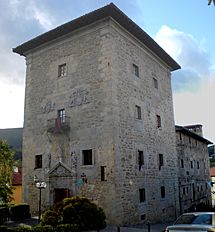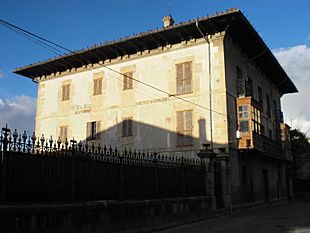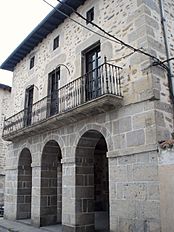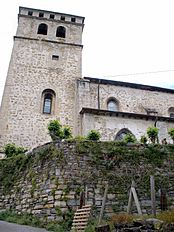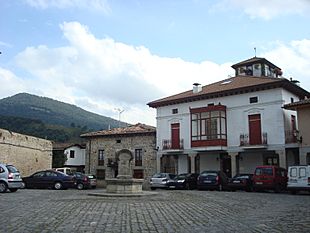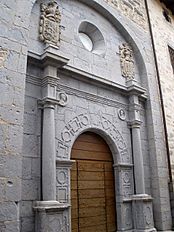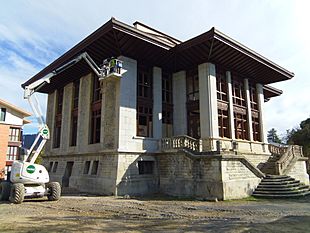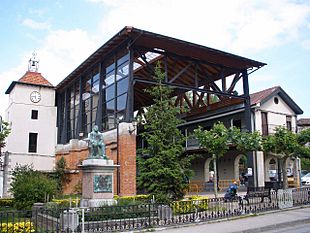Artziniega facts for kids
Artziniega (also called Artzainaga or Arceniega) is a town and municipality in the Álava province. It is part of the Basque Country in northern Spain. Artziniega is located in the northwest of Álava, close to the borders of Burgos and Biscay. Long ago, it was an important meeting point between the old Kingdom of Castile and the ports on the Bay of Biscay.
The town's name likely comes from the Basque words "Artzain-aga." This means "place of shepherds," which tells us about its history.
Contents
Amazing Nature
Artziniega is surrounded by beautiful nature. It sits in a mountainous area, near the Cantabrian Mountains. You can find the Gorobel and Sierra de Carbonilla mountains here. These mountains mark the edge of the Castilian plateau and are full of amazing sights. They have thick forests, tall cliffs, interesting rocks, and green mountain meadows.
Around Artziniega, there are many grasslands and some small gardens. In the past, people grew a lot of wheat, barley, and grapes here. But now, most of these areas are used for grazing animals. Some parts have also become new neighborhoods.
In the mountains, you'll find many native trees like oaks, holm oaks, maples, and ash trees. On Mount Ganzorrotz, there are many yew trees. They are so numerous in some spots that they form entire yew forests!
In 2016, the largest laurel forest in the Basque Country was found on Mount Otsati. This forest stretches across both Álava and Burgos.
Near the Sanctuary of Our Lady of the Oak, there's a very old oak tree. It's more than 500 years old and is considered a special tree of the Basque Country.
You can also see large areas of pine forests. On Mount Pando, there are special kinds of pines. On Mount Peñalba, different types of pines have been planted to suit the soil and weather.
Many animals live in these areas. You might spot wild boars, roe deer, hares, and even genets. There are also many birds of prey flying overhead.
Town History
Early Times and the Middle Ages
People have lived in the Artziniega area since ancient times. In the Church Cave, scientists found very old human remains. Not far away, a Headstone with Latin writing was found. This stone was likely for a local sea god, showing that the Romans were once here.
At the Sanctuary of Our Lady of the Oak, people found remains of a Roman settlement. This settlement dates back to between the 4th and 6th centuries. A stone stele from the 9th century was also found there.
Artziniega's written history began in 1272. That year, King Alfonso X El Sabio of Castile gave Artziniega its town charter. The king probably wanted to create a new town between Urduña and Balmaseda. This would help him compete with the powerful lords of Biscay. However, the kings of Castile soon became lords of Biscay themselves. So, Artziniega didn't become a major trading center.
After its founding, Artziniega followed the rules of Biscay for local matters. For money and taxes, it followed the rules of Vitoria-Gasteiz. The town was once attacked in 1366. For a long time, powerful lords had the right to choose mayors in Artziniega. But they never did. Instead, the townspeople chose their own mayors in public meetings.
Modern Times
During the Middle Ages, Artziniega, like other places, faced conflicts. These were called the Wars of the Bands. Rival families fought for control of the land. Artziniega was important for trade between the Kingdom of Castile and the ports on the Bay of Biscay. This meant some families became quite wealthy. However, most people in Artziniega worked in farming and raising animals. The town was also well-known for making Txakoli wine.
In the 15th century, the town created rules for daily life. These rules show that people grew wheat and grapevines. They also raised animals and worked in mills. There were also jobs like weavers, waiters, and bakers. The weekly market was very important. Artziniega was the economic center of its region. Its yearly September fairs lasted for fifteen days!
During this time, a group called the Junta de Ordunte was formed. It brought together Artziniega and nearby towns. They worked together to manage common things, like using the mountains and pastures.
After the Middle Ages, Artziniega grew. New areas outside the town walls were built. Money from discoveries in the Americas also helped the town develop. Many people from Artziniega became rich in the Americas. For example, in 1590, a man named Pedro Sáenz de Ubaldi started a hospital. Later, in 1608, the first schools in Artziniega were founded with money from Pedro de Oribe Salazar.
There were also some interesting events. Some young people in Artziniega refused to join the army. In 1674, a representative from Artziniega was not allowed to speak at a meeting. This was because he only spoke Euskara and not Spanish.
Recent Times
During the last Carlist war, Artziniega saw fighting. The town's important documents and records were burned. In the Spanish Civil War, Artziniega was also affected. In 1937, the town was taken over by troops. The mayor of Artziniega, Juan Zabalgoitia, was put in prison.
In recent years, especially during the later part of the dictatorship, Artziniega started to grow. New neighborhoods like Eguzkimendi, Arenaza, and El Palacio were built. This growth has continued very quickly. The town's population is now about 1,700 people. Many more people also visit or live there part-time.
Old Buildings and Art
Historic Quarter
Artziniega has one of the best-preserved medieval towns in the Basque Country. It still has its original layout. The old town is on a hill with three parallel streets. Two smaller streets connect them. This old structure is so well preserved because the town didn't grow as big as planned.
The oldest houses in the upper part of the town date back to the 16th century. Many of them have been updated over time. The town used to have walls around it, but they were not very strong. By the 17th century, most of the walls were gone. Only parts of them can be seen today, especially behind the Parish church.
Important Buildings
Artziniega has many different kinds of important buildings from different times.
Buildings in the Historic Quarter
- Parish of Our Lady of the Assumption: This is an important church.
- Convent of the Augustinian Nuns: A convent where nuns live.
- Ortiz de Molinillo and Velasco's Tower: An old tower that belonged to a powerful family.
- Bengoa's Tower: Another historic tower.
- Palaces from the 18th century: Large, fancy houses built a long time ago.
Other Important Buildings
- Sanctuary of Our Lady of the Oak: A special religious place with an amazing altarpiece.
- Large houses from the 18th century: More big, old houses outside the main historic area.
- Ethnographic Museum: A museum where you can learn about the local culture and history.
- Chapels: Small churches or places of worship.
Gallery
See also
 In Spanish: Arceniega para niños
In Spanish: Arceniega para niños



